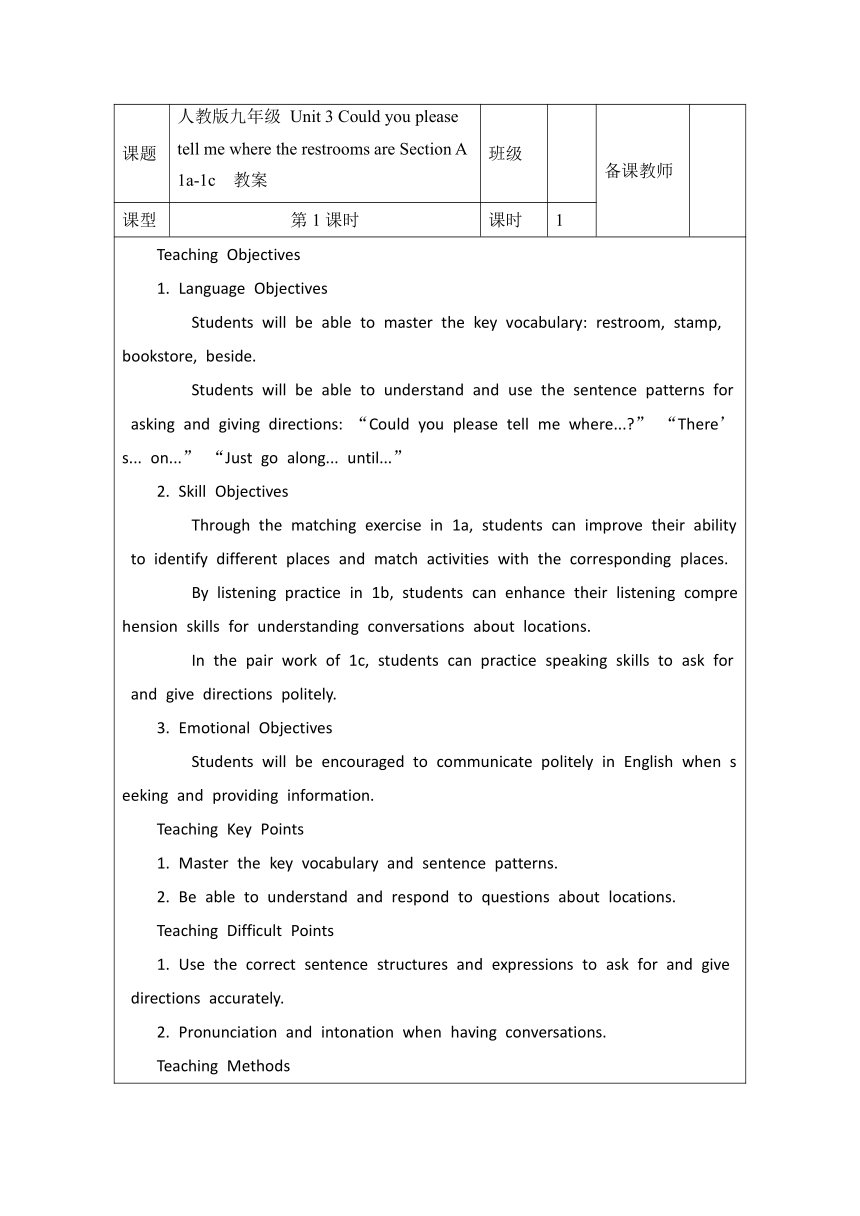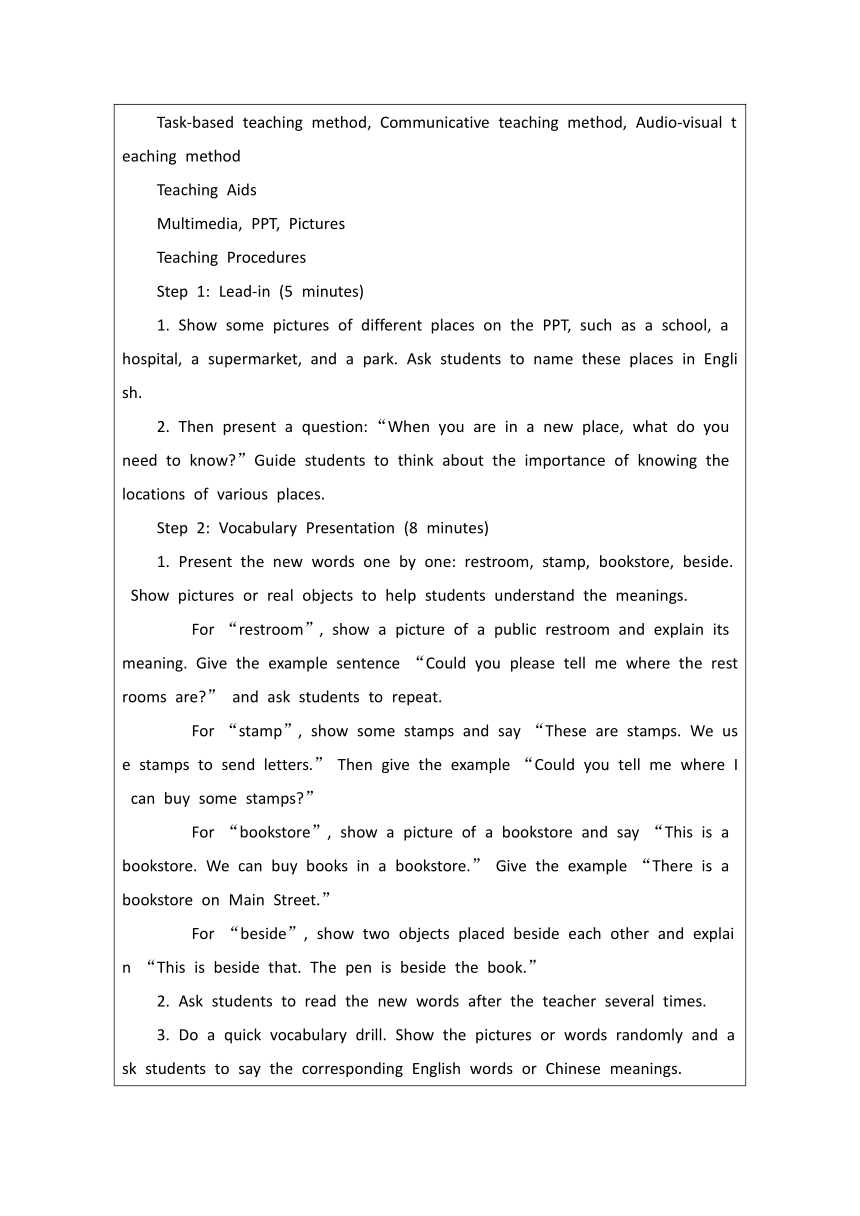人教版九年级Unit 3 Could you please tell me where the restrooms are Section A 1a-1c英文版教案(表格式)
文档属性
| 名称 | 人教版九年级Unit 3 Could you please tell me where the restrooms are Section A 1a-1c英文版教案(表格式) |

|
|
| 格式 | docx | ||
| 文件大小 | 22.4KB | ||
| 资源类型 | 教案 | ||
| 版本资源 | 人教新目标(Go for it)版 | ||
| 科目 | 英语 | ||
| 更新时间 | 2024-10-14 22:31:53 | ||
图片预览


文档简介
课题 人教版九年级 Unit 3 Could you please tell me where the restrooms are Section A 1a-1c 教案 班级 备课教师
课型 第1课时 课时 1
Teaching Objectives 1. Language Objectives Students will be able to master the key vocabulary: restroom, stamp, bookstore, beside. Students will be able to understand and use the sentence patterns for asking and giving directions: “Could you please tell me where... ” “There’s... on...” “Just go along... until...” 2. Skill Objectives Through the matching exercise in 1a, students can improve their ability to identify different places and match activities with the corresponding places. By listening practice in 1b, students can enhance their listening comprehension skills for understanding conversations about locations. In the pair work of 1c, students can practice speaking skills to ask for and give directions politely. 3. Emotional Objectives Students will be encouraged to communicate politely in English when seeking and providing information. Teaching Key Points 1. Master the key vocabulary and sentence patterns. 2. Be able to understand and respond to questions about locations. Teaching Difficult Points 1. Use the correct sentence structures and expressions to ask for and give directions accurately. 2. Pronunciation and intonation when having conversations. Teaching Methods Task-based teaching method, Communicative teaching method, Audio-visual teaching method Teaching Aids Multimedia, PPT, Pictures Teaching Procedures Step 1: Lead-in (5 minutes) 1. Show some pictures of different places on the PPT, such as a school, a hospital, a supermarket, and a park. Ask students to name these places in English. 2. Then present a question: “When you are in a new place, what do you need to know ” Guide students to think about the importance of knowing the locations of various places. Step 2: Vocabulary Presentation (8 minutes) 1. Present the new words one by one: restroom, stamp, bookstore, beside. Show pictures or real objects to help students understand the meanings. For “restroom”, show a picture of a public restroom and explain its meaning. Give the example sentence “Could you please tell me where the restrooms are ” and ask students to repeat. For “stamp”, show some stamps and say “These are stamps. We use stamps to send letters.” Then give the example “Could you tell me where I can buy some stamps ” For “bookstore”, show a picture of a bookstore and say “This is a bookstore. We can buy books in a bookstore.” Give the example “There is a bookstore on Main Street.” For “beside”, show two objects placed beside each other and explain “This is beside that. The pen is beside the book.” 2. Ask students to read the new words after the teacher several times. 3. Do a quick vocabulary drill. Show the pictures or words randomly and ask students to say the corresponding English words or Chinese meanings. Step 3: 1a - Matching Exercise (8 minutes) 1. Show the picture in 1a on the PPT. Explain the task to students: “Look at the picture and match the activities with the places you can do them.” 2. Give students a few minutes to complete the matching exercise individually. 3. Check the answers with the whole class. Ask some students to share their answers and explain their reasoning. Step 4: 1b - Listening Practice (8 minutes) 1. Before listening, preview the questions and options in 1b. Explain the task to students: “You will listen to a conversation and complete the dialogues. Pay attention to where people can get what they want.” 2. Play the recording for the first time. Students listen carefully and try to catch the main idea. 3. Play the recording for the second time. Students listen and complete the dialogues. 4. Check the answers. Play the recording again if necessary and pause at key points to explain and clarify. Step 5: Language Points Explanation (6 minutes) 1. Analyze and explain the key sentence patterns and expressions in 1b, such as “Could you please tell me where... ” and “There’s... on...” Explain the usage and structure of “Could you please tell me where... ” and give some examples for students to practice. Illustrate the meaning and usage of “There’s... on...” with pictures and sentences. 2. Point out the polite expressions used in the conversations and emphasize the importance of being polite when asking for directions. Step 6: 1c - Pair Work (6 minutes) 1. Present the example dialogue in 1c on the PPT. Explain the task to students: “Work in pairs. Use the information in 1a to make conversations about asking for and giving directions.” 2. Give students a few minutes to prepare their dialogues. 3. Invite some pairs to come to the front and act out their dialogues. Encourage other students to listen carefully and give comments. Step 7: Summary and Homework (3 minutes) 1. Summarize the key points of this lesson, including the new vocabulary and sentence patterns for asking and giving directions. 2. Assign homework: Ask students to write a short passage about how to get to a place they like from their home, using the expressions learned in this lesson.
课型 第1课时 课时 1
Teaching Objectives 1. Language Objectives Students will be able to master the key vocabulary: restroom, stamp, bookstore, beside. Students will be able to understand and use the sentence patterns for asking and giving directions: “Could you please tell me where... ” “There’s... on...” “Just go along... until...” 2. Skill Objectives Through the matching exercise in 1a, students can improve their ability to identify different places and match activities with the corresponding places. By listening practice in 1b, students can enhance their listening comprehension skills for understanding conversations about locations. In the pair work of 1c, students can practice speaking skills to ask for and give directions politely. 3. Emotional Objectives Students will be encouraged to communicate politely in English when seeking and providing information. Teaching Key Points 1. Master the key vocabulary and sentence patterns. 2. Be able to understand and respond to questions about locations. Teaching Difficult Points 1. Use the correct sentence structures and expressions to ask for and give directions accurately. 2. Pronunciation and intonation when having conversations. Teaching Methods Task-based teaching method, Communicative teaching method, Audio-visual teaching method Teaching Aids Multimedia, PPT, Pictures Teaching Procedures Step 1: Lead-in (5 minutes) 1. Show some pictures of different places on the PPT, such as a school, a hospital, a supermarket, and a park. Ask students to name these places in English. 2. Then present a question: “When you are in a new place, what do you need to know ” Guide students to think about the importance of knowing the locations of various places. Step 2: Vocabulary Presentation (8 minutes) 1. Present the new words one by one: restroom, stamp, bookstore, beside. Show pictures or real objects to help students understand the meanings. For “restroom”, show a picture of a public restroom and explain its meaning. Give the example sentence “Could you please tell me where the restrooms are ” and ask students to repeat. For “stamp”, show some stamps and say “These are stamps. We use stamps to send letters.” Then give the example “Could you tell me where I can buy some stamps ” For “bookstore”, show a picture of a bookstore and say “This is a bookstore. We can buy books in a bookstore.” Give the example “There is a bookstore on Main Street.” For “beside”, show two objects placed beside each other and explain “This is beside that. The pen is beside the book.” 2. Ask students to read the new words after the teacher several times. 3. Do a quick vocabulary drill. Show the pictures or words randomly and ask students to say the corresponding English words or Chinese meanings. Step 3: 1a - Matching Exercise (8 minutes) 1. Show the picture in 1a on the PPT. Explain the task to students: “Look at the picture and match the activities with the places you can do them.” 2. Give students a few minutes to complete the matching exercise individually. 3. Check the answers with the whole class. Ask some students to share their answers and explain their reasoning. Step 4: 1b - Listening Practice (8 minutes) 1. Before listening, preview the questions and options in 1b. Explain the task to students: “You will listen to a conversation and complete the dialogues. Pay attention to where people can get what they want.” 2. Play the recording for the first time. Students listen carefully and try to catch the main idea. 3. Play the recording for the second time. Students listen and complete the dialogues. 4. Check the answers. Play the recording again if necessary and pause at key points to explain and clarify. Step 5: Language Points Explanation (6 minutes) 1. Analyze and explain the key sentence patterns and expressions in 1b, such as “Could you please tell me where... ” and “There’s... on...” Explain the usage and structure of “Could you please tell me where... ” and give some examples for students to practice. Illustrate the meaning and usage of “There’s... on...” with pictures and sentences. 2. Point out the polite expressions used in the conversations and emphasize the importance of being polite when asking for directions. Step 6: 1c - Pair Work (6 minutes) 1. Present the example dialogue in 1c on the PPT. Explain the task to students: “Work in pairs. Use the information in 1a to make conversations about asking for and giving directions.” 2. Give students a few minutes to prepare their dialogues. 3. Invite some pairs to come to the front and act out their dialogues. Encourage other students to listen carefully and give comments. Step 7: Summary and Homework (3 minutes) 1. Summarize the key points of this lesson, including the new vocabulary and sentence patterns for asking and giving directions. 2. Assign homework: Ask students to write a short passage about how to get to a place they like from their home, using the expressions learned in this lesson.
同课章节目录
- Unit 1 How can we become good learners.
- Section A
- Section B
- Unit 2 I think that mooncakes are delicious!
- Section A
- Section B
- Unit 3 Could you please tell me where the restroom
- Section A
- Section B
- Unit 4 I used to be afraid of the dark.
- Section A
- Section B
- Unit 5 What are the shirts made of?
- Section A
- Section B
- Review of Units 1-5
- Unit 6 When was it invented?
- Section A
- Section B
- Unit 7 Teenagers should be allowed to choose their
- Section A
- Section B
- Unit 8 It must belong to Carla.
- Section A
- Section B
- Unit 9 I like music that I can dance to.
- Section A
- Section B
- Unit 10 You're supposed to shake hands.
- Section A
- Section B
- Review of Units 6-10
- Unit 11 Sad movies make me cry.
- Section A
- Section B
- Unit 12 Life is full of the unexpected
- Section A
- Section B
- Unit 13 We're trying to save the earth!
- Section A
- Section B
- Unit 14 I remember meeting all of you in Grade 7.
- Section A
- Section B
- Review of Units 11-14
